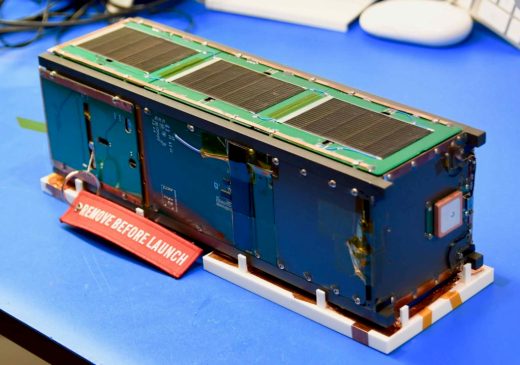A sampling of recent articles, videos, and images from space-related science news items:
Asteroids
** JAXA Hayabusa2 made a successful 2nd sample grab from asteroid Ryugu on July 11th. The :
- Japan’s Hayabusa2 probe makes ‘perfect’ touchdown on asteroid – AFP/Phys.org
- Touchdown Two: Japan’s Hayabusa2 Scores Success – Leonard David
- Hayabusa 2 cleared for second touchdown on asteroid – Spaceflight Now
From SFN:
The robot explorer’s sampling mechanism works by firing a metal bullet into the asteroid once the probe’s sampler horn, which extends from one side of the spacecraft, contacts the surface. The projectile is designed to blast away rock and dust on the asteroid’s surface, then direct the material through the sampler horn into a collection chamber inside the Hayabusa 2 spacecraft.
This image shows debris thrown up from the surface of Ryugu by the bullet.

A diagram of the touch-and-go surface sampling operation:

More about the The 2nd touchdown – JAXA Hayabusa2 project
** Help OSIRIS-REx mission map the rugged surface of the Bennu asteroid NASA Invites Public to Help Asteroid Mission Choose Sample Site | NASA
Citizen scientists assemble! NASA’s OSIRIS-REx mission to the asteroid Bennu needs extra pairs of eyes to help choose its sample collection site on the asteroid – and to look for anything else that might be scientifically interesting.

The OSIRIS-REx spacecraft has been at Bennu since Dec. 3, 2018, mapping the asteroid in detail, while the mission team searches for a sample collection site that is safe, conducive to sample collection and worthy of closer study. One of the biggest challenges of this effort, which the team discovered after arriving at the asteroid five months ago, is that Bennu has an extremely rocky surface and each boulder presents a danger to the spacecraft’s safety. To expedite the sample selection process, the team is asking citizen scientist volunteers to develop a hazard map by counting boulders.
“For the safety of the spacecraft, the mission team needs a comprehensive catalog of all the boulders near the potential sample collection sites, and I invite members of the public to assist the OSIRIS-REx mission team in accomplishing this essential task,” said Dante Lauretta, OSIRIS-REx principal investigator at the University of Arizona, Tucson.
For this effort, NASA is partnering with CosmoQuest, a project run out of the Planetary Science Institute that supports citizen science initiatives. Volunteers will perform the same tasks that planetary scientists do – measuring Bennu’s boulders and mapping its rocks and craters – through the use of a simple web interface. They will also mark other scientifically interesting features on the asteroid for further investigation.
The boulder mapping work involves a high degree of precision, but it is not difficult. The CosmoQuest mapping app requires a computer with a larger screen and a mouse or trackpad capable of making precise marks. To help volunteers get started, the CosmoQuest team provides an interactive tutorial, as well as additional user assistance through a Discord community and livestreaming sessions on Twitch.
For more info see:
Microgravity Science & Technology R&D
** SpaceX Cargo Dragon to deliver wide range of science and technology experiments to the ISS. Liftoff of mission CRS-18 is currently set for July 21st at 7:35 pm EDT (2335 GMT)
- SpaceX CRS-18 Mission Overview – ISS National Lab
- SpaceX CRS-18 Will Launch With Multiple Student Experiments – ISS National Lab
- Rise of Private-Sector Research Onboard the ISS National Lab on Display with SpaceX CRS-18 Mission – ISS National Lab
- In-orbit Manufacturing and Drug Development Research Among U.S. National Lab-sponsored Payloads Destined for the Space Station
Highlights of Science Launching on SpaceX CRS 18 – July 8, 2019 –
Solar Science
** Sunspot count near zero in June. Faint spots subsequently show signs of start of next cycle: Sunspot update June 2019: Down to zero again, with next cycle making an appearance | Behind The Black
These two visible sunspots for the next solar cycle are very significant. They indicate that we will have an upcoming solar maximum, and are not heading into a grand minimum, when no sunspots are visible for decades.
Their appearance however does not mean that solar minimum is over. On the contrary, the solar cycles typically overlap by one or two years, with new sunspots for the next solar cycle appearing even as the Sun ramps down to minimum and remains relatively inactive for many months.
I cannot deny that I will be disappointed if a grand minimum does not occur. Such an event would have been a wonderful opportunity for solar scientists to get answers to their many questions about the Sun’s solar cycles that today remain unanswered and will likely not be answerable while the Sun follows its behavior of the last three hundred years.
At the same time, if the upcoming solar cycle is weak, as has been predicted by some solar scientists, it will help confirm some theories that try to explain the Sun’s behavior.
Check SpaceWeather.com for the daily sunspot count. More solar images and measurements can be found on the Space-for-All page The Sun & Space Weather.




